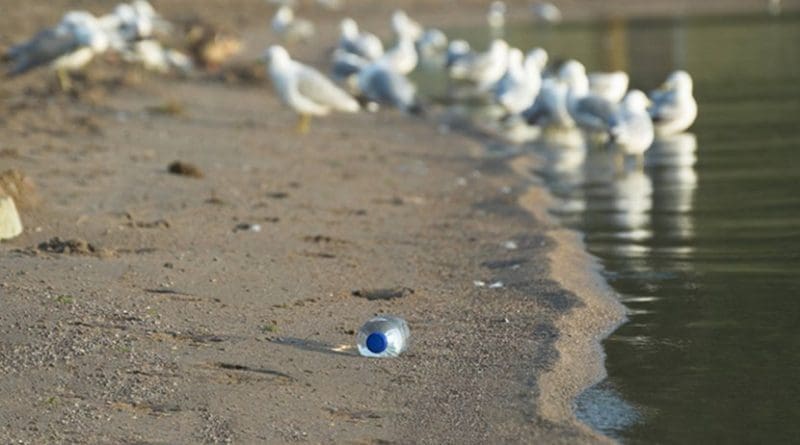Plastic Litter: The Challenge At Sea – Analysis
By IPCS
By Vijay Sakhuja*
A number of innovations and initiatives that are shaping the oceans and seas can potentially help ensure that these water bodies remain environmentally and ecologically stable. These range from greener and efficient vessels propelled by solar and wind energy, sustainable use of sea-based living and non-living resources, conservation of marine ecology, and making the oceans free of pollutants, particularly plastic litter.
Plastic litter in the oceans particularly has invited international condemnation. Images of floating islands of trash, also called ‘gyres’, carcasses of marine mammals, turtles entangled in fishing nets, and birds dying due to ingestion of plastic have enraged the general public. Several environment groups have highlighted the growing menace of marine plastic litter, and civic bodies, governments and international organisations have made note of these developments.
A number of initiatives are currently underway to address the problem. These can be placed into at least four categories. First, there is lack of public awareness of the fact that nearly 80 per cent of marine litter has origins on land. Due to poor waste management practices, untreated sewage often drains into the seas. At another level, mariners are accused of littering the oceans with trash from ships, and fishermen are responsible for discarding gear and losing nets. Nearly 70 per cent of heavy marine litter like glass, metal, engineering equipment, electrical devices, containerised waste including radioactive materials sink to the ocean floor – but these have washed ashore. For instance, the ungoverned Somali waters had been used as a dumping ground for radioactive materials such as uranium, lead, mercury and industrial chemical waste. However, lighter weight materials such as straws, cigarette waste (butts), plastic bottles, polystyrene products and such other materials float and remain suspended together to form ‘gyres’.
Second, there are preventive programmes led by the plastic industry. The industry has shown commitment and has been closely associated with several programmes built around best environment practices, plastics recycling/recovery, and plastic pellet containment. In March 2011, nearly fifty plastics associations across the globe signed the Declaration of the Global Plastics Associations for Solutions on Marine Litter. However, they still need to conduct research to enhance product disposal and identify innovative solutions for the litter problems which could even be part of corporate social responsibility including stewardship of cleaning plastic litter in coastal areas.
Third, a variety of innovative technological solutions are being developed to address marine litter. These are low-cost devices and can be developed at the local level. For instance, the V5 Seabin unit is a floating debris interception device capable of receiving 1.5 kg per day of the floating debris and is suitable for recreational water bodies such as marinas, yacht clubs, lakes, or other areas with calm waters. Likewise, a technical team of researchers in the UK is developing algorithms and software to “automatically detect and map plastic and marine litter on coastlines using drone imagery.” It also involves using techniques to help distinguish different types of litter such as plastic waste, ropes, fishing gear, drink bottles, etc.
Fourth, there is now a proliferation of Beach Action Groups that have voluntarily begun addressing marine litter on waterfronts. Significantly, they enjoy popular public support. For instance, in Mumbai, India, the Versova Residents Volunteers (VRV) supported by the local civic body, residents and fishermen, removed 5.3 million kg of trash from Versova beach over 85 weeks, making this unique voluntary clean-up the largest in the world. The initiative was a catalyst for The Clean Seas global campaign launched in Bali, Indonesia; and a similar group in Bali has begun clearing their beaches of plastic.
Finally, marine litter is a problem created by humans and thus must also be solved by humans. In essence, human beings are part of the problem and the solution. This would involve inspiring people through awareness programmes on marine litter and the critical necessity to keep waterfronts clean. This must be supported by civic bodies and local governments to adopt stringent laws and regulation on use and disposal of plastic, complete ban on use of single-use plastics, and preventing untreated sewage draining into the sea. The industry, besides taking these issues under corporate social responsibility, must innovate and adopt better technology for plastic disposal. Also, ocean litter has no geographic or political boundaries and the remedy and solutions must be developed through global partnerships and involve international organisations.
* Vijay Sakhuja
Former Director, National Maritime Foundation (NMF), New Delhi


The most realistic way of achieving reductions in plastic waste entering the marine environment is by opening up basic geospatial data of litter on land, to understand marine litters’ pre-marine terrestrial characteristics which can be used to improve, locate and evaluate public service implementation and policy on land to educate people and institutions about how to stop the transfer of plastic from land to sea, where plastic becomes far more damaging. This is why I built openlittermap.com, which works like a game to map and open up data on litter.